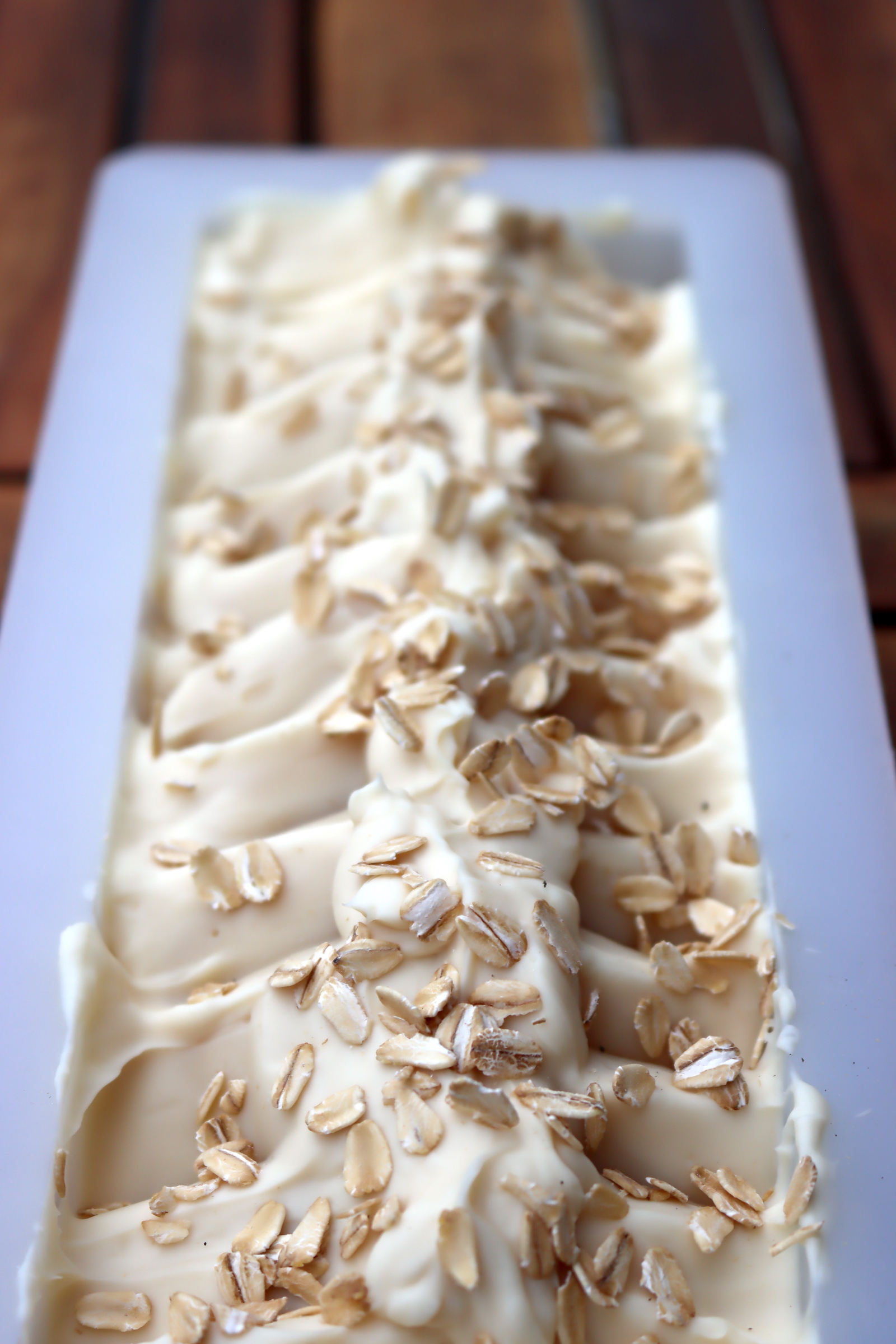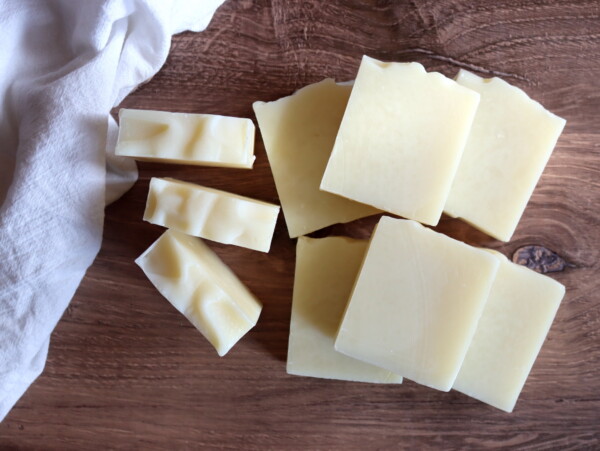Affiliate disclosure: This post may contain affiliate links. Please see our Privacy Policy.
Soap making is a fun way to get crafty in the kitchen, and if you select the right recipe, it’s easy enough to make spectacular homemade soap (even as a beginner).

Table of Contents
- Soap Making Methods
- Melt and Pour Soap
- Re-Batching Soap or Milling Soap
- Cold Process Soap
- Hot Process Soap
- Liquid Soap, Laundry Soap, and Detergents
- Soapmaking Recipes for Beginners
- Melt and Pour Soap Making Recipes
- Cold Process Soap Making Recipes
- Hot Process Soap Making Recipes
- Re-Batched Soap Making Ideas
- Homemade Beauty Products
My daughter absolutely loves homemade body products, and she wants to make just about everything under the sun. We’ve tried out hand at homemade lip balms, lotion bars, bath bombs, and even a few homemade body butters.
Most of those are very simple to make, and just involve mixing a few ingredients together in the right proportions.
Soapmaking, on the other hand, can be intimidating, especially when you’re working with lye.
The thing is, it’s actually not all that different than other simple body products. All you’re doing is mixing a few ingredients together in the right proportion and the right order.
This past week, my second grader and I made our first batch of homemade cold process soap together, and she absolutely loved it.
While I’ve made soap before, I’m now on the hunt for simple, beginner-friendly soap-making recipes to make with my daughter.
Many of these easy soapmaking recipes don’t involve lye, including melt-and-pour soapmaking recipes and milled soap-making recipes. Those are perfect for absolute beginners just trying to dip their toes into the craft of soapmaking.
I’ve also included beginner cold process and hot process soapmaking recipes, which do involve lye, but they’re a simple and straightforward way to get comfortable making soap from scratch.
(I’d strongly recommend that you read through my post on common soapmaking mistakes and how to fix them. These are the main problems new soapmakers face, and I cover exactly how to prevent all of these issues.)

Soap Making Methods
Believe it or not, there are actually quite a few different ways to make soap at home. Each method has its benefits, and some are a lot easier than others.
Melt and Pour Soap
If you’re worried about working with lye, melt-and-pour soapmaking recipes are a worry-free place to start. These easy soapmaking recipes start with a prepared soap base, which takes the chemistry out of soapmaking, but leaves all the fun crafty parts.
You’re starting with a base of ready-made soap, and then choosing colors, scents, shapes and styles for your finished product. Believe it or not, most of the fun parts of soapmaking start after the “soap” is already made.
Re-Batching Soap or Milling Soap
Milled soaps are a good place to start for beginners because they’ll allow you to experiment with the artistry of soap without really having to deal with lye (or expensive melt-and-pour bases).
Just start with high-quality soap, and re-mill it into something unique. A good option for the crafty and creative, rather than the hardcore DIY person who wants to make soap from scratch.
Cold Process Soap
The classic method for making high-quality homemade soap, cold process soapmaking mixes oils with lye and then allows them to react at room temperature.
The initial reaction is fast, but the soap needs to cure for about 4 to 6 weeks before use. This allows all the last bits of lye to finish their reaction, but it also allows the soap to firm up to a nice finished texture.
The hands-on process is only about 30 minutes, but you’ll still have to wait a few weeks before you can use the soap.
It’s worth the wait, as cold processed soaps are some of the highest quality homemade soaps available.
Hot Process Soap
Making hot process soaps is similar to cold process, and the recipes all start the same. You make the soap base, but then you cook the soap in a crock pot for an hour or two, instead of allowing the reaction to happen slowly over several weeks at room temperature.
The heat from the crock pot speeds up the reaction, but it also changes the texture and color of the finished soap. It’s a good option if you want a handmade gift, but can’t wait weeks for it to be ready.
Liquid Soap, Laundry Soap, and Detergents
While you might assume that liquid soap, body wash, dish soap, and laundry detergent are not all that different from making soap at home, the process is quite different.
I will cover how to make bar soaps for now, as these are quite different from basic soapmaking (and require very different chemistry that’s not for beginners).
Soapmaking Recipes for Beginners
Personally, my favorite soap-making recipes are cold process because I think it makes the best quality homemade soap, even if it does require working with lye and waiting for the soap to cure. I realize that’s not for everyone, and many beginners just aren’t comfortable working with lye from the start. That’s when melt-and-pour soaps or hand-milled soap might be a better option.
Even if you are comfortable working with lye, you may not want to wait 6+ weeks for their soap to cure, especially if they’re trying to make it as a last-minute gift. In that case, opt for hot process soap.
Regardless of where you are in your soap-making journey, I’ve included recipes for each soap-making method.
Melt and Pour Soap Making Recipes
When starting with a melt-and-pour soapmaking base, the only limit is your own creativity. Try out different colors, molds, mix-ins, and shapes to your heart’s content.
I’d suggest reading my guide on how to make melt and pour soap before you get started.
- Goats Milk & Honey Soap
- Spring Weeds Gardener’s Soap
- Calendula, Honey, and Oatmeal Soap
- Rosehip Melt and Pour Soap
- Lavender and Rosemary Soap

Cold Process Soap Making Recipes
This is the classic method for making high-quality soaps at home, and though it does involve lye and a bit of curing time, I think the results are well worth the wait.
I would suggest reading my guide to making soap at home before getting started, as I cover the entire cold process soapmaking routine in detail.
- Goats Milk and Honey Soap
- Rosehip Soap
- Simple Castile Soap
- Shea Butter Soap
- Basic Beginner Cold Process Soap

Hot Process Soap Making Recipes
Really, you can make any cold process soap into a hot process recipe by simply curing it in a crock pot for a few hours before pouring it into a soap mold.
These recipes, however, are specifically designed to be easy beginner hot process soap-making recipes that assume you plan to speed up the reaction with the heat right from the beginning.
If this is your first time, I’d suggest reading how to make hot process soap before you get started.
- Basic Moisturizing Hot Process Soap
- Honey and Oat Hot Process Soap
- Blueberry Hot Process Soap
- Dandelion Hot Process Soap
- Lemon Poppyseed Hot Process Soap
- Aloe Hot Process Soap

Re-Batched Soap Making Ideas
When you mill or “re-batch” soaps, you’re starting with soap that’s perfectly serviceable and already in bar form ready to use. These are just recipes that allow you to take that store-bought soap and make it your own, by crafting it into unique shapes or adding colors, scents, exfoliants or botanical mix-ins.
Think of these as up-cycling, rather than true soap making. Still, they’re some of the easiest processes and result in stunning handmade gifts.
If you’ve never done it before, I’d suggest starting by reading how to make hand-milled soap.
- Wildflower Rebatch Soap
- Pink Clay and Primrose Milled Soap
- Rose Rebatch Soap
- Lump of Coal Rebatch Soap
- Cucumber Loofa Rebatch Soap
- Lavender Citrus Rebatch Soap
This guide to using leftover soap scraps for rebatching milled soap is also pretty helpful.
Homemade Beauty Products
Hand-made soap is just the beginning, and it’s arguably a lot more difficult than these simple body products.





Thank you for sharing your wealth of knowledge with us! We are expecting a newborn in our family in a few months. I am wondering which of the soaps you’ve mentioned will be best and most mild?
Thanks, in advance, for your time and assistance!
I would go with a simple soap without a lot of extras and I would definitely stay away from essential oils in a soap for newborns.